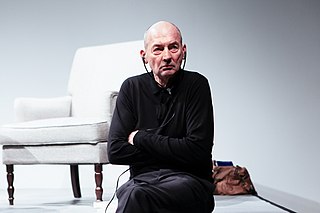
Remment Lucas Koolhaas is a Dutch architect, architectural theorist, urbanist and Professor in Practice of Architecture and Urban Design at the Graduate School of Design at Harvard University. He is often cited as a representative of Deconstructivism and is the author of Delirious New York: A Retroactive Manifesto for Manhattan.

Constant Anton Nieuwenhuys, better known as Constant, was a Dutch painter, sculptor, graphic artist, author and musician.

Dame Zaha Mohammad Hadid was an Iraqi-British architect, artist and designer, recognised as a major figure in architecture of the late-20th and early-21st centuries. Born in Baghdad, Iraq, Hadid studied mathematics as an undergraduate and then enrolled at the Architectural Association School of Architecture in 1972. In search of an alternative system to traditional architectural drawing, and influenced by Suprematism and the Russian avant-garde, Hadid adopted painting as a design tool and abstraction as an investigative principle to "reinvestigate the aborted and untested experiments of Modernism [...] to unveil new fields of building".

MVRDV is a Rotterdam, Netherlands-based architecture and urban design practice founded in 1993, with additional offices in Berlin, New York, Paris, and Shanghai. It is currently regarded as one of the world's finest architecture firms. MVRDV is an acronym of the founding members' surnames: Winy Maas, Jacob van Rijs, and Nathalie de Vries.
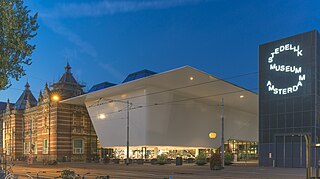
The Stedelijk Museum Amsterdam, colloquially known as the Stedelijk, is a museum for modern art, contemporary art, and design located in Amsterdam, Netherlands.
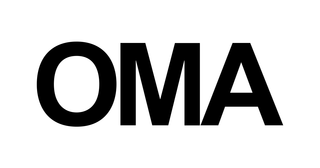
The Office for Metropolitan Architecture (OMA) is an international architectural firm with offices in Rotterdam, New York, Hong Kong, Doha, and Australia. The firm is currently led by eight partners - Rem Koolhaas, Reinier de Graaf, Ellen van Loon, Shohei Shigematsu, Iyad Alsaka, Chris van Duijn, Jason Long, and managing partner and architect David Gianotten.
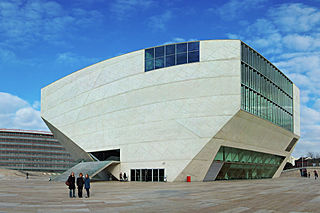
The Casa da Música is a concert hall in Porto, Portugal. It was designed by architect Rem Koolhaas and opened in 2005.

Contemporary architecture is the architecture of the 21st century. No single style is dominant. Contemporary architects work in several different styles, from postmodernism, high-tech architecture and new references and interpretations of traditional architecture to highly conceptual forms and designs, resembling sculpture on an enormous scale. Some of these styles and approaches make use of very advanced technology and modern building materials, such as tube structures which allow construction of buildings that are taller, lighter and stronger than those in the 20th century, while others prioritize the use of natural and ecological materials like stone, wood and lime. One technology that is common to all forms of contemporary architecture is the use of new techniques of computer-aided design, which allow buildings to be designed and modeled on computers in three dimensions, and constructed with more precision and speed.

Mark Antony Wigley is a New Zealand-born architect and author based in the United States. From 2004 to 2014, he was the Dean of Columbia University's Graduate School of Architecture, Planning and Preservation.
Madelon Vriesendorp is a Dutch artist, painter, sculptor and art collector. She was married to Rem Koolhaas and best known as one of the co-founders of the Office of Metropolitan Architecture (OMA) in the early 1970s. Vriesendorp would often create visuals and graphics for OMA in the early years.

The Kunsthal is an art space in Rotterdam. It opened in 1992.

The Netherlands Architecture Institute (NAI) was a cultural institute for architecture and urban development, which comprised a museum, an archive plus library and a platform for lectures and debates. The NAI was established in 1988 and was based in Rotterdam since 1993. It ceased to exist in 2013, when it became part of Het Nieuwe Instituut.

The Leeum, Samsung Museum of Art is a museum in Hannam-dong, Yongsan District, Seoul, South Korea. It is run by the Samsung Foundation of Culture.

Gabriel Lester is an inventor, visual artist and film director living and working in Amsterdam.

Louise Schouwenberg studied psychology at the Radboud University Nijmegen, sculpture at the Gerrit Rietveld Academy in Amsterdam, and philosophy at the University of Amsterdam. She worked as a visual artist from 1985–2003. Since then her primary focus has been on art and design theory. Schouwenberg is head of the Masters programme Contextual Design at Design Academy Eindhoven, and mentor of the Masters programme Inside, Interior Architecture, of the Royal Academy of Arts in The Hague.

Hella Jongerius is a Dutch industrial designer.
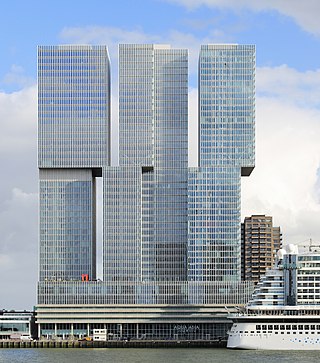
De Rotterdam is a building on the Wilhelminapier in Rotterdam, designed by the Office for Metropolitan Architecture in 1998 and developed by Edge. The complex is located between the KPN Tower and Rotterdam Cruise Terminal and was finalized at the end of 2013. On 21 November 2013, the municipality of Rotterdam, as the largest user, received the keys. The design provides space for offices, a hotel and apartments. The 44 floors amount to a total floor space area of about 160,000 m², making it the largest building in the Netherlands.

The modern Qatari art movement emerged in the mid-20th century, as a result of the new-found wealth acquired from oil exports and the subsequent modernization of Qatari society. Because of Islam's non-inclusive stance of depictions of sentient beings in visual arts, paintings historically played an insignificant role in the country's culture. Other visual art forms such as calligraphy, architecture, and textiles were more highly regarded in the Bedouin tradition.
Louise Lemoine is a French video artist and filmmaker. She is an associate of the film production and publishing company Bêka & Partners.

Delirious New York: A Retroactive Manifesto for Manhattan is a 1978 book, written by Dutch architect Rem Koolhaas. The book serves as a retroactive manifesto for Manhattan between 1850 and 1960, analyzing the development of architecture and urban design throughout New York's history from the founding of New Amsterdam by the Dutch, to the design of the Headquarters of the United Nations by Le Corbusier. Rem Koolhaas describes the concept of 'Manhattanism', the theory of the creation and functioning of the city of New York, at length in the book.

















